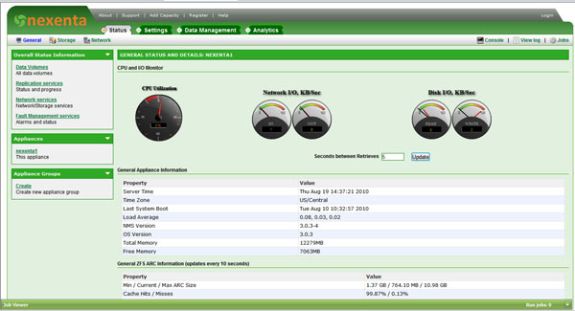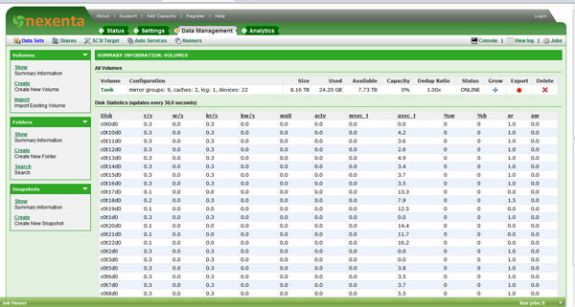ZFS - Building, Testing, and Benchmarking
by Matt Breitbach on October 5, 2010 4:33 PM EST- Posted in
- IT Computing
- Linux
- NAS
- Nexenta
- ZFS
Nexenta
Nexenta is to OpenSolaris what OpenFiler is to Linux or FreeNAS is to FreeBSD. It is a purpose built version of OpenSolaris designed primarily around storage networking including NFS, CIFS, and iSCSI/FC block based storage. Nexenta has taken a lot of time building a great front-end to manage ZFS enabled storage and integrate a plug-in manager that can extend the abilities of a standard x86 platform to rival the best
Nexenta comes in three flavors, Nexenta Core, Nexenta Community, and Nexenta Enterprise. The availability of these three versions allows you to select what kind of product you want, and what kind of expenditures that you will incur.
Nexenta Core is the most basic of the options, but it is also the most forgiving in terms of licensing. Nexenta Core is a command line interface platform only. It is based on an OpenSolaris kernel, and an Ubuntu Userland. There is no limit to the amount of storage that you can configure or use with Nexenta Core, and it is completely free. Nexenta Core can be found here.
Nexenta Community is the next step up. Nexenta Community is based on Nexenta Core, and includes a great GUI interface for managing all aspects of the storage platform. Nexenta Community is also free, but it is limited to 12TB of used storage. Nexenta Community Edition can be found here.
Nexenta Enterprise is the top-level offering. Nexenta Enterprise is a superset of Nexenta Community with many Enterprise level features, including support options. Nexenta Enterprise is licensed based on RAW storage capacity. You can find pricing information here.
Screenshots of web GUI
Nexenta has been very easy to use in our testing. After a few minutes of familiarization with the interface everything is pretty straight forward. You can go from a bare installation to something that has an array configured, an iSCSI target configured, and is ready to take data in a matter of 5-10 minutes. All of the features for sending out notifications and for lighting up indicator lights work as expected and are easy to configure. With just a few menu clicks you're ready to enter all of the information that the system needs to notify you about any problems that it encounters.
Some of the shortcomings that we saw in the Nexenta Enterprise offering were in the reporting and support areas of the product. We did not investigate the reporting problem in depth, as it was not pertinent to the performance data of the system. We would expect that with a little troubleshooting it would be something that would be easily resolved. Throughout the testing process though the daily reports stated that there was no network traffic being generated even though we were loading the interface quite heavily during testing.
This brings us to our next issue that we had with Nexenta, and that was the support channels. We would have gladly troubleshot the issues with reporting if we thought it was going to be done in a timely manner. Since we were using the Enterprise Trial license the support was lackluster at best. We were assured by sales representatives that paid-for support is much faster and much better than the "free trial" support. Free Trial support is treated as their lowest priority support queue. We were not impressed with this as we have always thought of a time-limited free trial period to be pre-sales. If you want to convert someone from a non-paying free trial to a paid product, show them how good the product and support is during that period.












102 Comments
View All Comments
L. - Wednesday, March 16, 2011 - link
Too bad you already have the 15k drives.2) I wanted to say this earlier, but I'm quite confident that SLC is NOT required for a SLOG device, as with current wear leveling, unless you actually write more than <MLC disk capacity> / day there is no way you'll ever need the SLC's extended durability.
3) Again, MLC SSD's, good stuff
4) Yes again
5) not too shabby
6) Why use 15k or 7k2 rpm drives in the first place
All in all nice project, just too bad you have to start from used equipment.
In my view, you can easily trash both your similar system and Anandtech's test system and simply go for what the future is going to be anyway :
Raid-10 MLC drives, 48+RAM, 4 CPU's (yes those MLC's are going to perform so much faster you will need this - quite a fair chance you'll need AMD stuff on that as 4-socket is their place) and mainly and this is the hardest part, sata 6 Gb/s * many with a controller that can actually handle the bandwidth.
Overall you'd get a much simpler, faster and cleaner solution (might need to upgrade your networking though to match with the rest).
L. - Wednesday, March 16, 2011 - link
Of course, 6 months later .. .its not the same equation ;) Sorry for the necroB3an - Tuesday, October 5, 2010 - link
I like seeing stuff like this on Anand. It's a shame it dont draw as much interest as even the poor Apple articles.Tros - Tuesday, October 5, 2010 - link
Actually, I was just hoping to see a ZFS vs HFS+ comparison for the higher-end Macs. But with the given players (Oracle, Apple), I don't know if the drivers will ever be officially released.Taft12 - Wednesday, October 6, 2010 - link
Doesn't it? This interests me greatly and judging by the number of comments is as popular as any article about the latest video or desktop CPU techgreenguy - Wednesday, October 6, 2010 - link
I have to say, kudos to you Anand for featuring an article about ZFS! It is truly the killer app for filesystems right now, and nothing else is going to come close to it for quite some time. What use is performance if you can't automatically verify that your data (and the system files that tells your system how to manipulate that data) was what it was the last time you checked?You picked up on the benefits of the SSD (low latency) before anyone else, it is no wonder you've figured out the benefits of ZFS too earlier than most of your compatriots as well. Well done.
elopescardozo - Tuesday, October 5, 2010 - link
Hi Matt,Thank you for the extensive report. In your testing results there are a few unexpected results. I find the difference between Nexenta and Open Solaris hard to understand, unless it is due to misalignment of the IO in the case of Nexenta.
A zvol (the basis for an iSCSI volume) is created on top of the ZFS pool with a certain block size. I believe the default is 8kB. Next you initialize the volume and format it with NTFS. By default the NTFS structure starts at sector 63 (sixty three, not a typo!), which means that every other 4kB cluster (the NTFS allocation size) falls over a zvol block boundary. That has a serious impact on performance. I saw a report of 70% improvement after properly alignment.
Is it possible that the Open Solaris and Nexenta pools were different in this respect, either because of different zvol block size (e.g. 8kB for Nexenta, 128kB for Open Solaris – larger blocks means less “boundary cases”) or differences in how the volumes were initialized and formatted?
mbreitba - Tuesday, October 5, 2010 - link
It's possible that the sector alignment could be a problem, but I believe the build that we tested, the default sector size was set to 128kB, which was identical to OpenSolaris. If that has changed, then we should re-test with the newest build to see if that makes any differences.cdillon - Tuesday, October 5, 2010 - link
Windows Server 2008 aligns all newly created partitions at 1MB, so his NTFS block access should have been properly aligned by default.Mattbreitbach - Tuesday, October 5, 2010 - link
I was unaware that Windows 2008 correctly aligned NTFS partitions now. Thanks for the info!